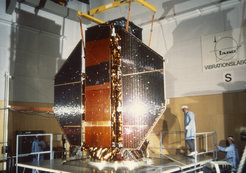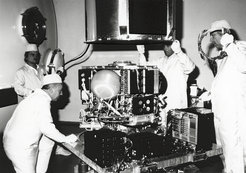X-ray eyes on the sky
ROSAT was launched 25 years ago
On 1 June 1990, the X-ray satellite ROSAT, which had been built under the scientific leadership by MPE, was launched from Cape Canaveral and sent its first light image to ground just two weeks later. During its first six months of operations, ROSAT performed the first deep all-sky survey with an imaging telescope, discovering more than 100,000 new X-ray sources. Subsequently it was used for many pointed observations over a period of eight years, ROSAT brought a wealth of new discoveries. Up to now, more than 4200 refereed scientific papers have been published using ROSAT data, which have been cited more than 150,000 times.

ROSAT was the biggest project at MPE. The idea of a large X-ray telescope goes back to the early 1970s and in 1975 the X-ray satellite suggested by MPE was recommended to be built by the committee for large-scale projects of the Ministry of Research and Technology (BMTF). Subsequently, the technical concept was developed in industrial studies and MPE started with the development of the focal instruments. After the BMFT decided in 1980 that large national projects needed substantial international contributions, NASA could be won over for the launch and for adding another focal instrument and the University of Leicester for participating with a small EUV telescope.

Thus, ROSAT carried two Wolter imaging telescopes operating in the soft X-ray (0.1-2.4 keV) and extreme ultraviolet (0.06-0.2 keV) ranges. In its focus were two position sensitive proportional counters (PSPC) developed by MPE and one high resolution imager (HRI) by the Harvard University. The integration and testing of the complete focal instrumentation was carried out at MPE, as well as the testing of the two telescopes in the MPE testing facility “Panter”. In addition, the prime ROSAT data centre is still at MPE, with all ROSAT data calibrated, archived and available here.
In February 1999, ROSAT finally lost its orientation and was shut down. In October 2011 it crashed into the Indian Ocean.

ROSAT targets ranged from nearby objects in our solar system, to stars and stellar remnants in the Milky Way and nearby galaxies to galaxy clusters and quasars at cosmological distances. With its much higher sensitivity and resolution than previous instruments, ROSAT brought a wealth of discoveries:
- the first X-ray image of the moon and the shadow it casts on the cosmic background,
- X-ray emission from comets,
- X-ray emission from Mars and Venus,
- X-ray emission from brown dwarf stars,
- the new class of supersoft X-ray sources in nearby galaxies, representing White Dwarfs showing nuclear burning at their surface,
- the first millisecond pulsar in X-rays,
- neutron stars showing purely thermal emission (the “glorious seven”),
- “shrapnel” in the Vela supernova remnant, interpreted as the fragments of the stellar explosion,
- determining the ratio of dark matter in galaxy clusters based on measuring their intensity and temperature distributions,
- the powerful jet of the active galactic nucleus NGC 1275 blowing bubbles into the intergalactic medium of the Perseus cluster,
- the capture of stars by black holes in the centres of ordinary galaxies

ROSAT resolved ~80% of the X-ray background into individual sources, mostly supermassive Black Holes in galactic nuclei.
and many more. It also answered the riddle of the cosmic X-ray background, dubbed the “Holy Grail of X-ray Astronomy” by its discoverer Riccardo Giacconi. ROSAT resolved about 80% of this diffuse emission into individual sources, mostly active galactic nuclei. Its main camera, the PSPC, was actually the first instrument which could image the X-ray background directly. The wealth of scientific results based on ROSAT data led to more than 4200 refereed scientific papers up to now, with more than 150,000 citations.
Experience gained by MPE staff with the construction of ROSAT and the scientific exploitation of its data contributed also the next generation of X-ray telescopes with participation of the institute: Since 1999, ESA’s XMM-Newton and NASA’s Chandra X-ray satellites are the current largest X-ray observatories; in the coming years, MPE will take part in the Russian-German mission Spektrum-X-Gamma with the X-ray telescope eROSITA, which from 2017 will perform an all-sky survey in X-rays 25 times more sensitive than ROSAT. In addition, MPE has a leading role in the preparation of the next ESA X-ray mission, Athena, which will be launched in 2028.















